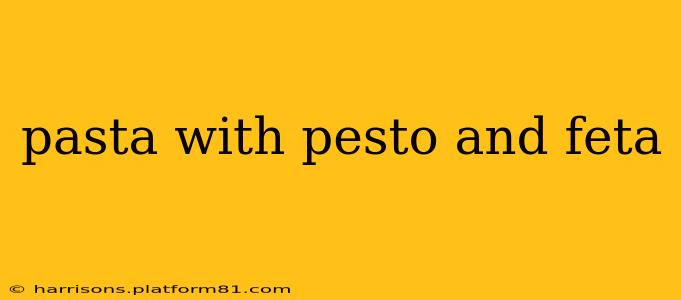Pasta with pesto and feta is a simple yet incredibly satisfying dish that embodies the vibrant flavors of the Mediterranean. This quick and easy recipe is perfect for a weeknight meal, a casual lunch, or even a light dinner party. The creamy pesto, salty feta, and perfectly cooked pasta create a harmonious blend of textures and tastes that will leave you wanting more. This post will explore variations, answer common questions, and guide you through creating the perfect pesto pasta with feta experience.
What kind of pasta is best for pesto and feta?
The best pasta for pesto and feta is a pasta that can hold the sauce well without becoming overly soggy. Short, tube-shaped pastas like penne, farfalle (bow ties), or rotini are excellent choices because their shapes allow the pesto and feta to cling beautifully. However, longer pasta like linguine or spaghetti also works well, especially if you prefer a slightly less coated pasta. Ultimately, the choice comes down to personal preference.
Is it better to use fresh or store-bought pesto?
While homemade pesto offers an unparalleled freshness and flavor, store-bought pesto can be a convenient alternative, especially on busy weeknights. If you opt for store-bought pesto, look for one with high-quality ingredients and minimal additives. Taste it before adding it to the pasta and adjust seasoning as needed. For a homemade pesto, you can find numerous recipes online—many use basil, pine nuts, garlic, Parmesan cheese, and olive oil.
How do I make pesto pasta with feta creamy?
The creaminess of pesto pasta with feta comes from a combination of factors: the pesto itself (which often contains olive oil), the feta cheese (which provides a salty, creamy element), and the pasta water. Adding a tablespoon or two of starchy pasta water to the sauce emulsifies it, creating a luscious, creamy texture that coats the pasta perfectly. Don't be afraid to experiment with the amount of pasta water to achieve your desired consistency.
How much feta cheese should I use?
The amount of feta cheese you use depends on your personal preference. A good starting point is about 1/4 cup of crumbled feta per pound of pasta. You can always add more or less depending on how salty and cheesy you like your dish. Remember that feta can be quite salty, so start with a smaller amount and add more to taste.
Can I add vegetables to pesto pasta with feta?
Absolutely! Adding vegetables elevates this simple dish to new heights. Cherry tomatoes, roasted red peppers, sun-dried tomatoes, zucchini, or spinach are all fantastic additions. Sauté your chosen vegetables before adding the pasta and pesto for optimal flavor and texture. Adding these ingredients adds nutritional value and visual appeal.
What are some variations of pesto pasta with feta?
The beauty of this recipe lies in its versatility. Here are a few delicious variations:
- Lemon Pesto Pasta with Feta: Add the zest and juice of a lemon to the pesto for a brighter, more vibrant flavor.
- Spicy Pesto Pasta with Feta: Incorporate a pinch of red pepper flakes or a dash of your favorite hot sauce for a spicy kick.
- Pesto Pasta with Feta and Chicken: Add grilled or roasted chicken for a more substantial meal.
- Pesto Pasta with Feta and Pine Nuts: Toasted pine nuts add a delightful crunch and nutty flavor.
Is pesto pasta with feta healthy?
This dish can be a healthy option, depending on the ingredients used. Pasta provides carbohydrates for energy, while pesto offers healthy fats and antioxidants from the basil. Feta cheese provides protein and calcium. However, the overall healthiness depends on portion size and the type of pasta and pesto used. Opting for whole wheat pasta and minimizing the amount of cheese can contribute to a healthier meal.
This simple yet elegant dish offers a multitude of possibilities. Experiment with different ingredients and techniques to create your own perfect version of pesto pasta with feta. Enjoy!
